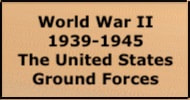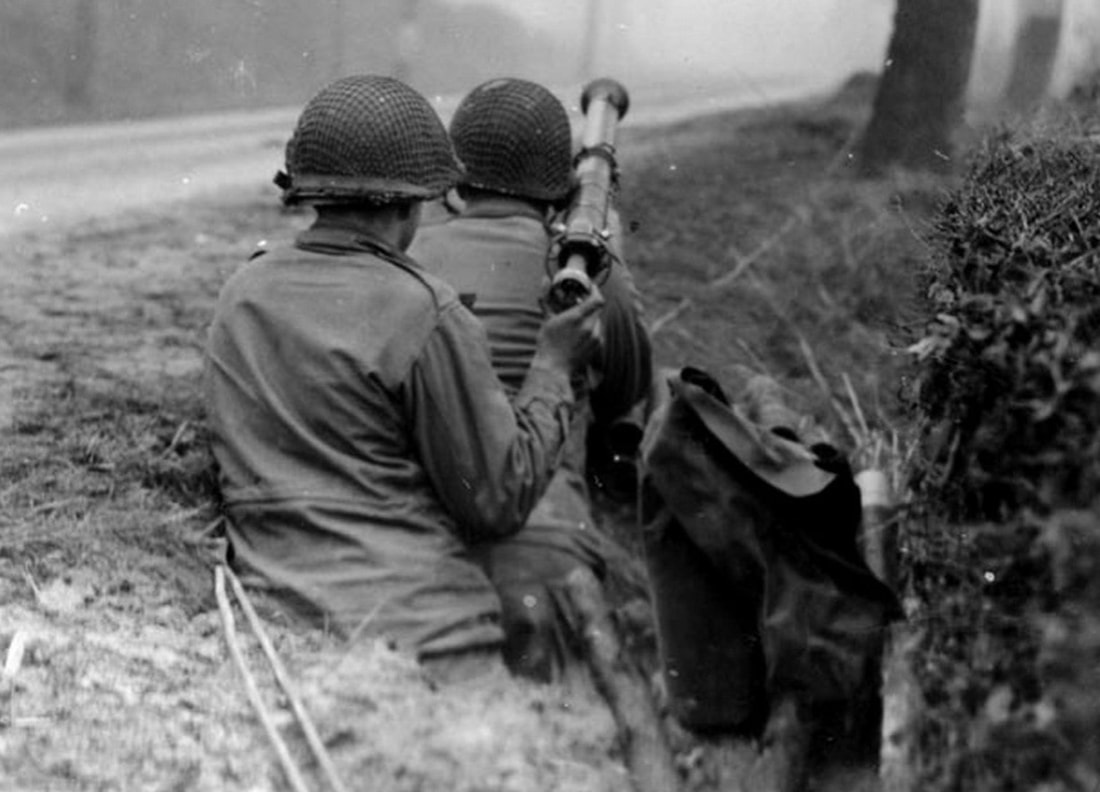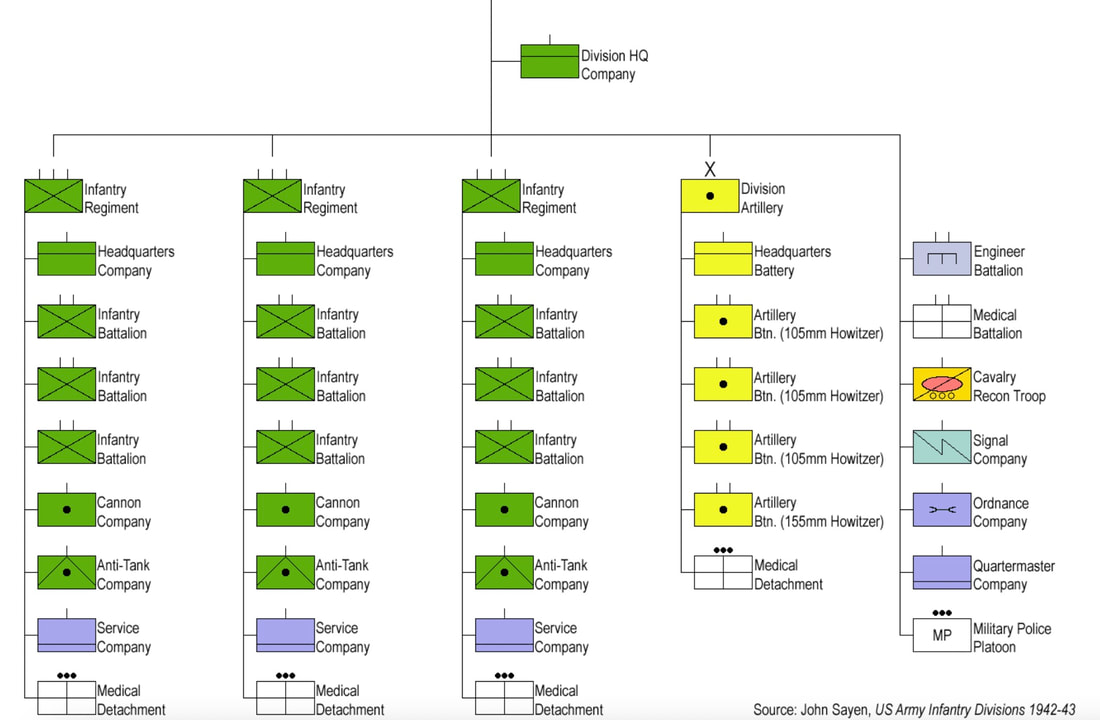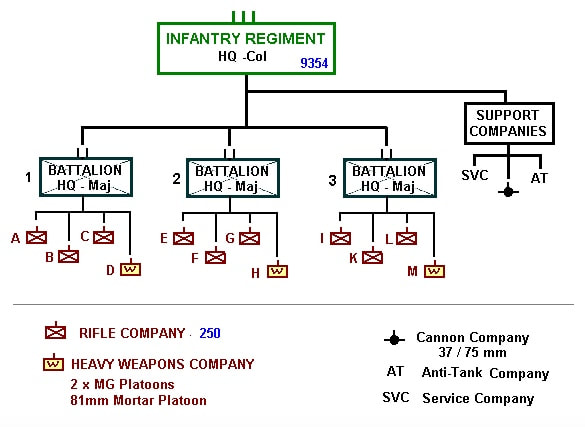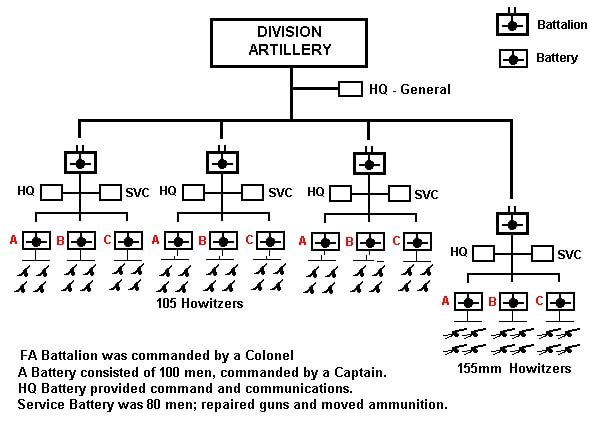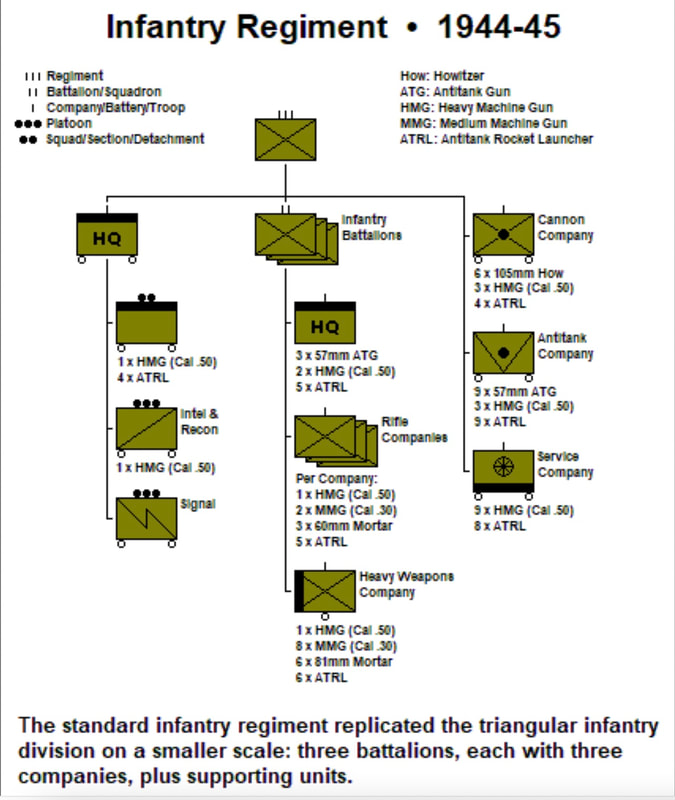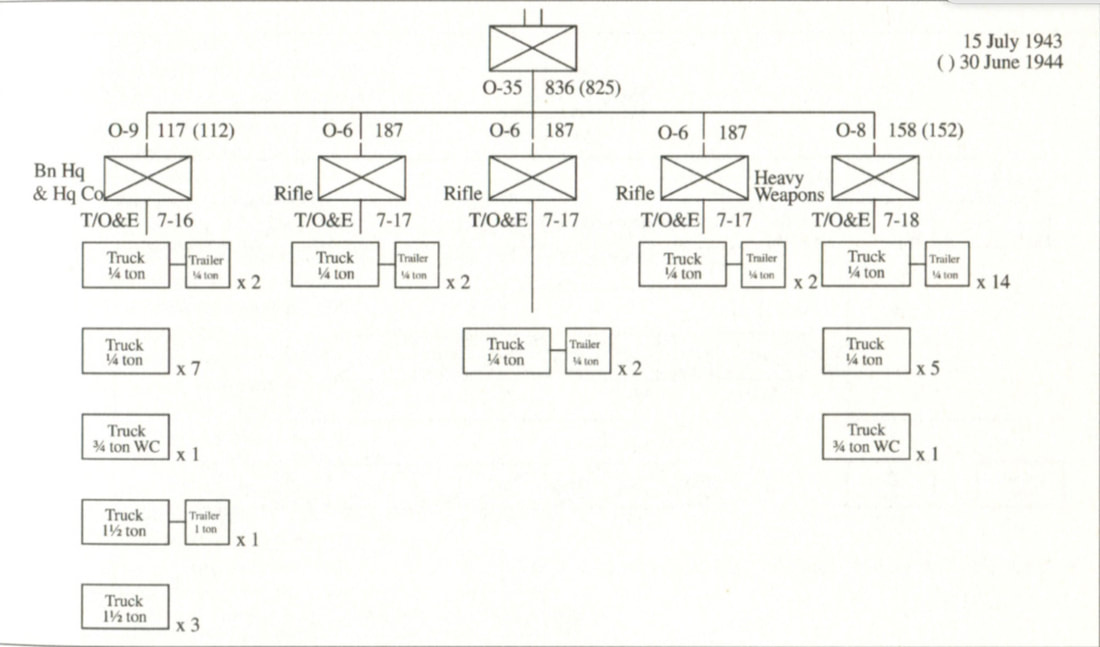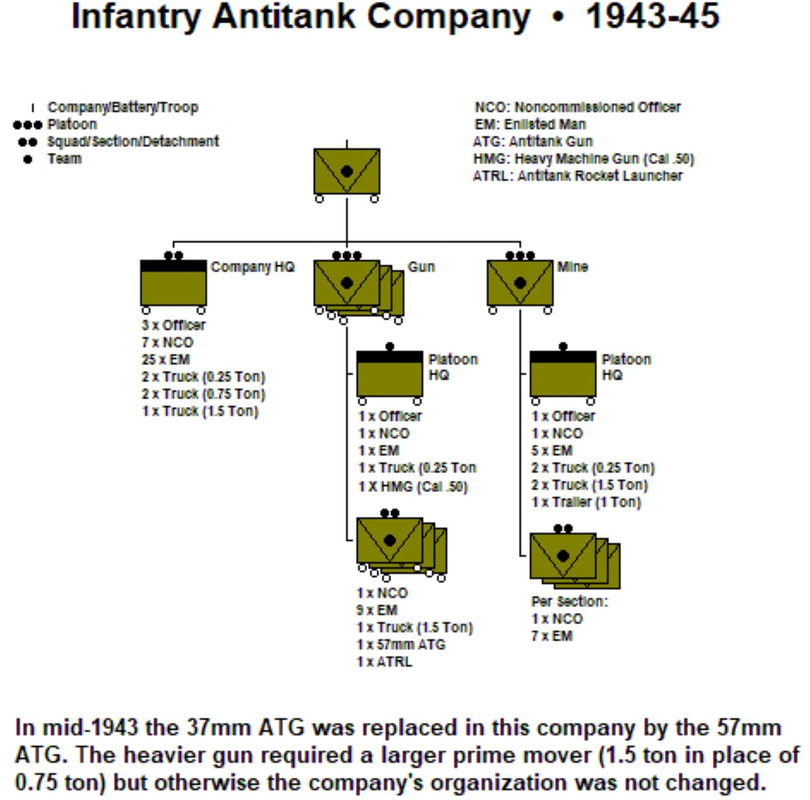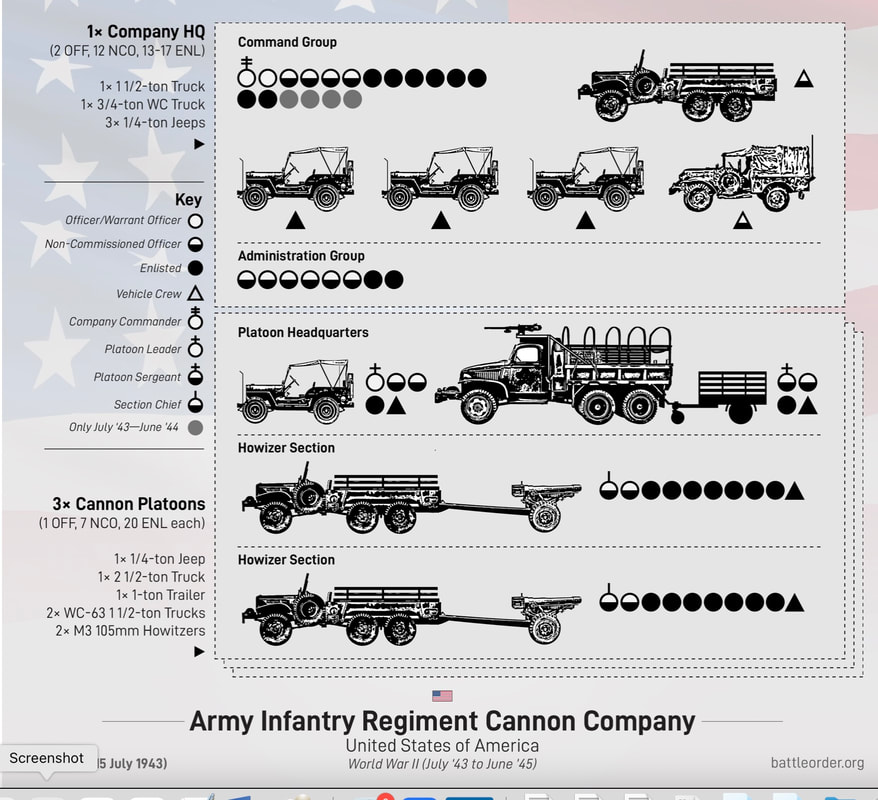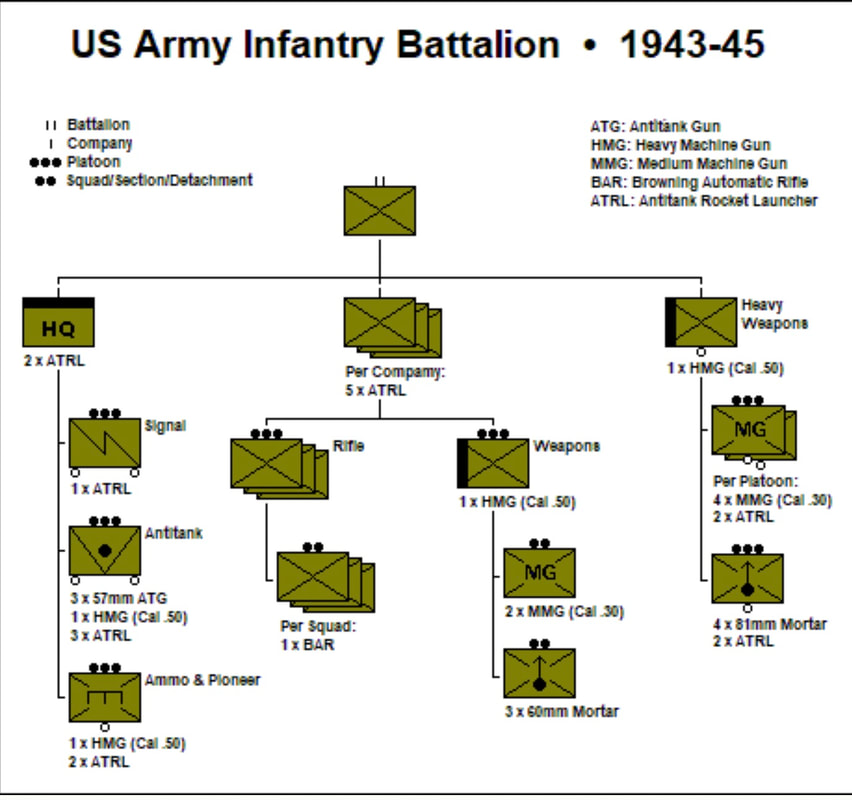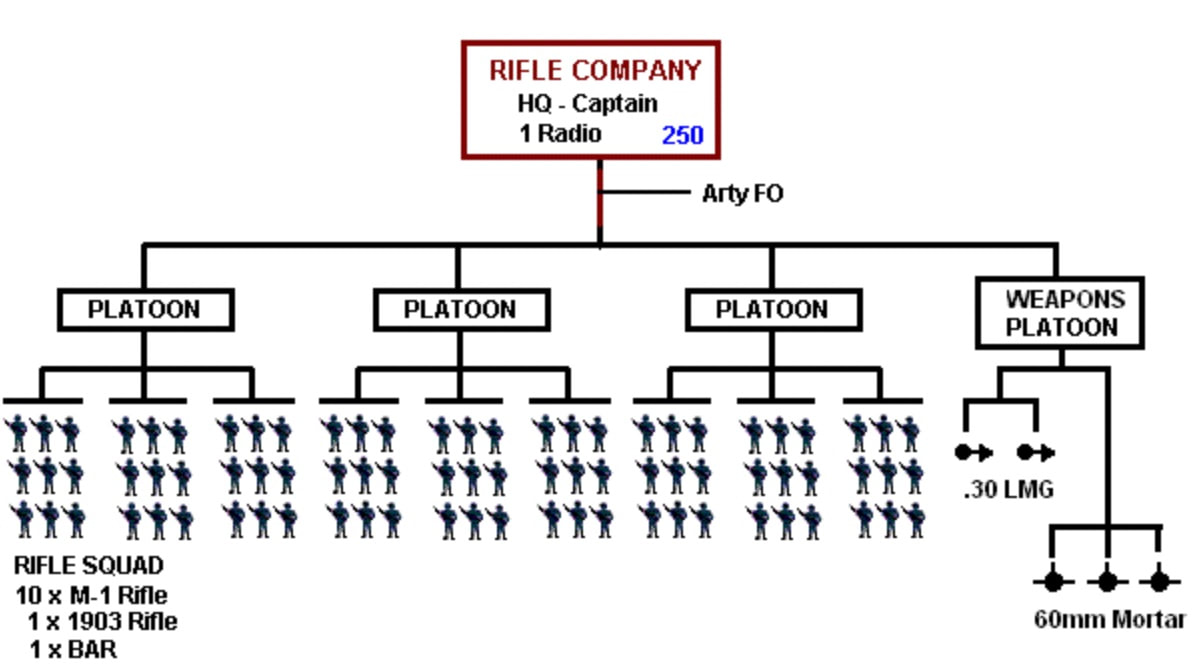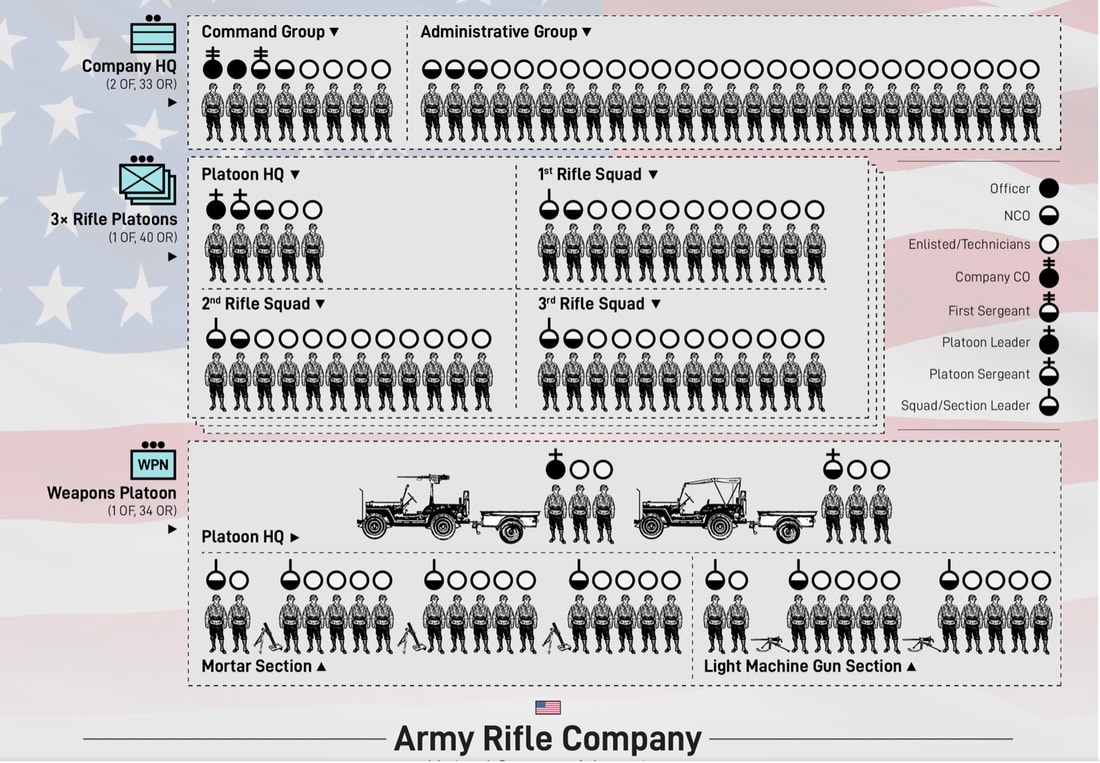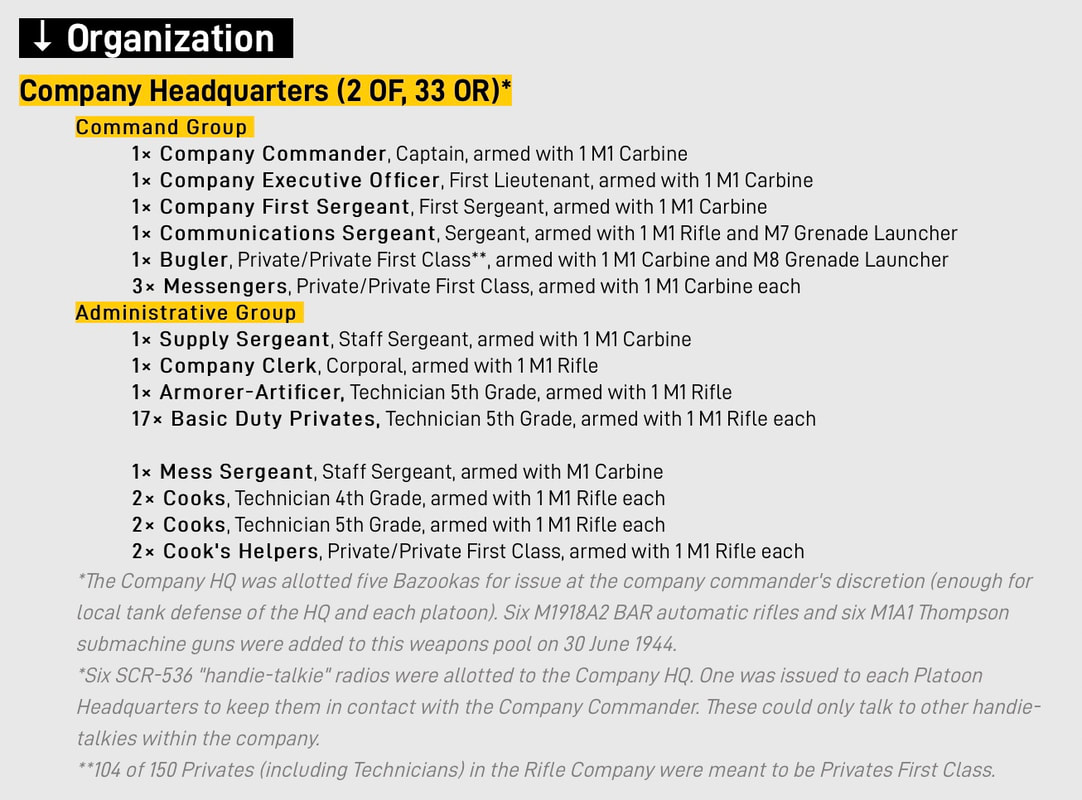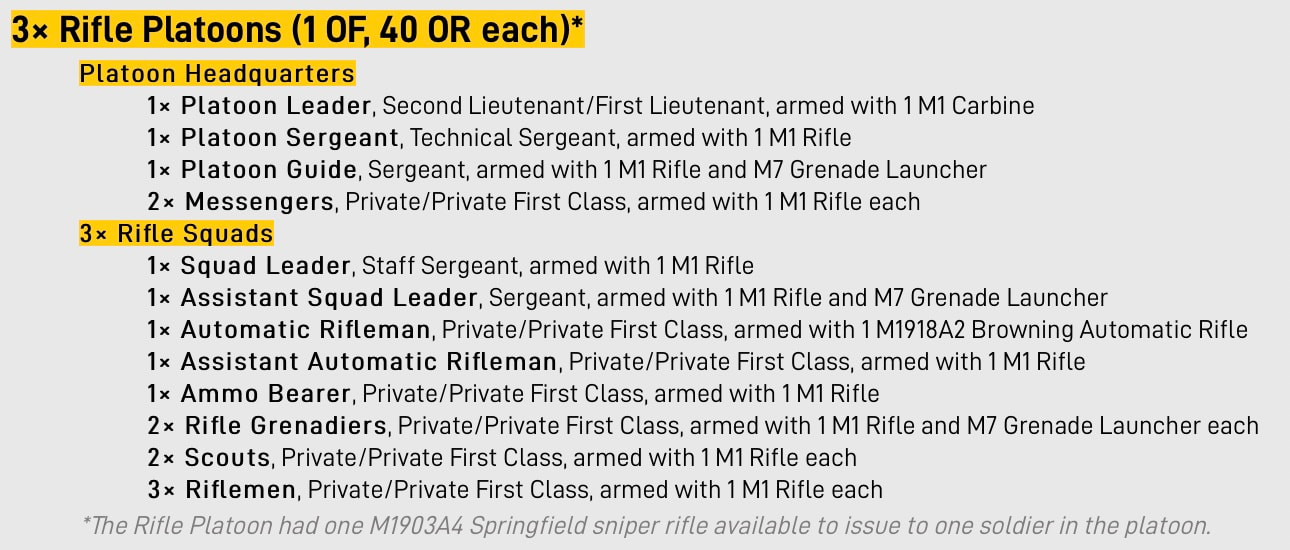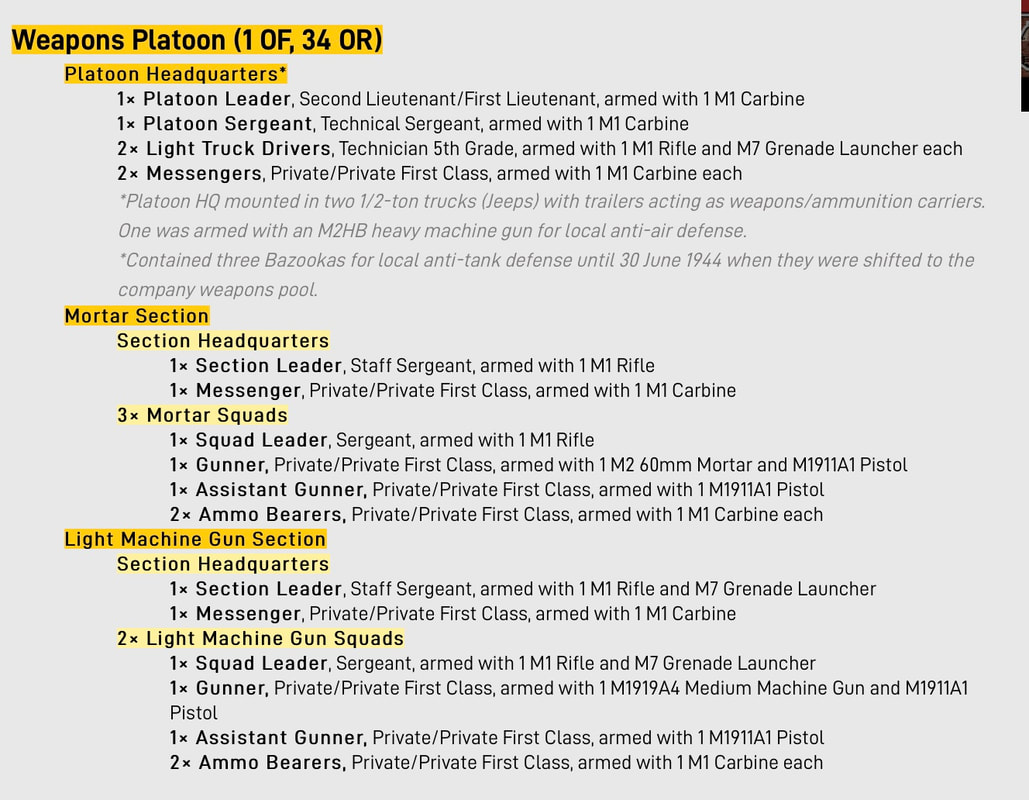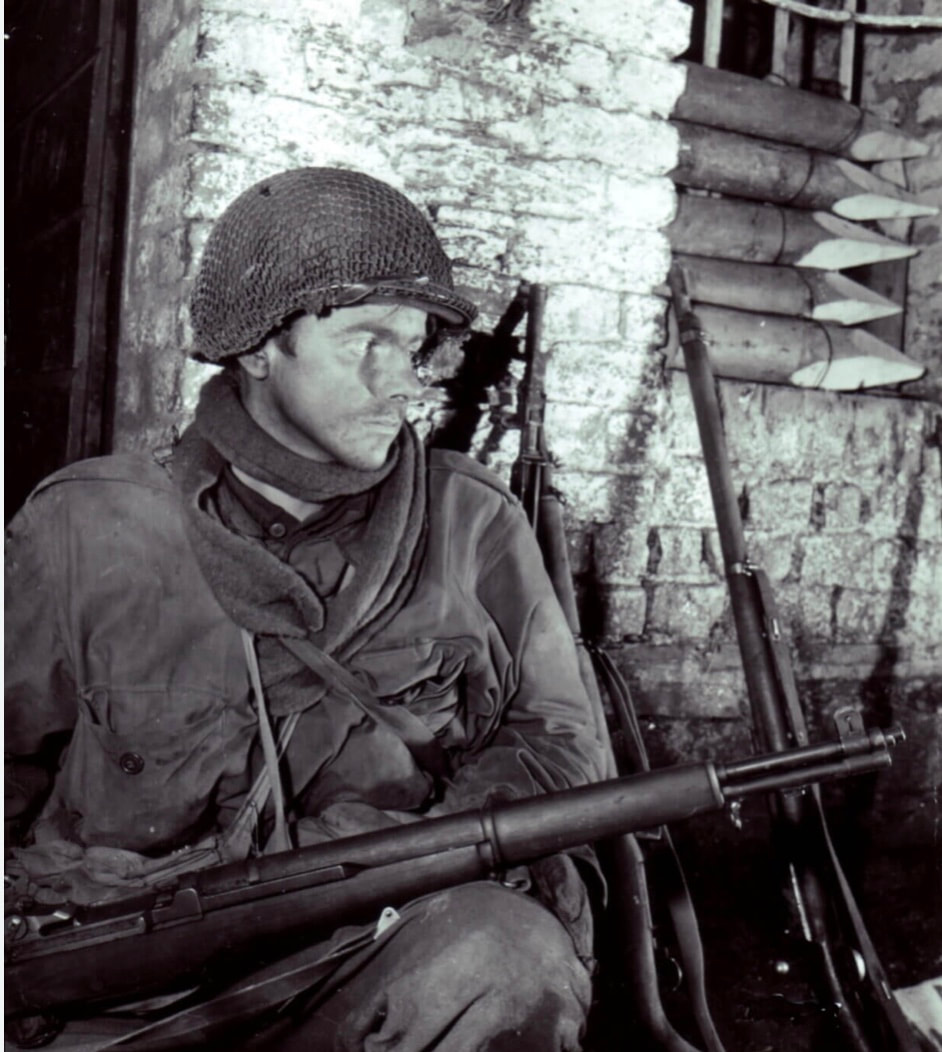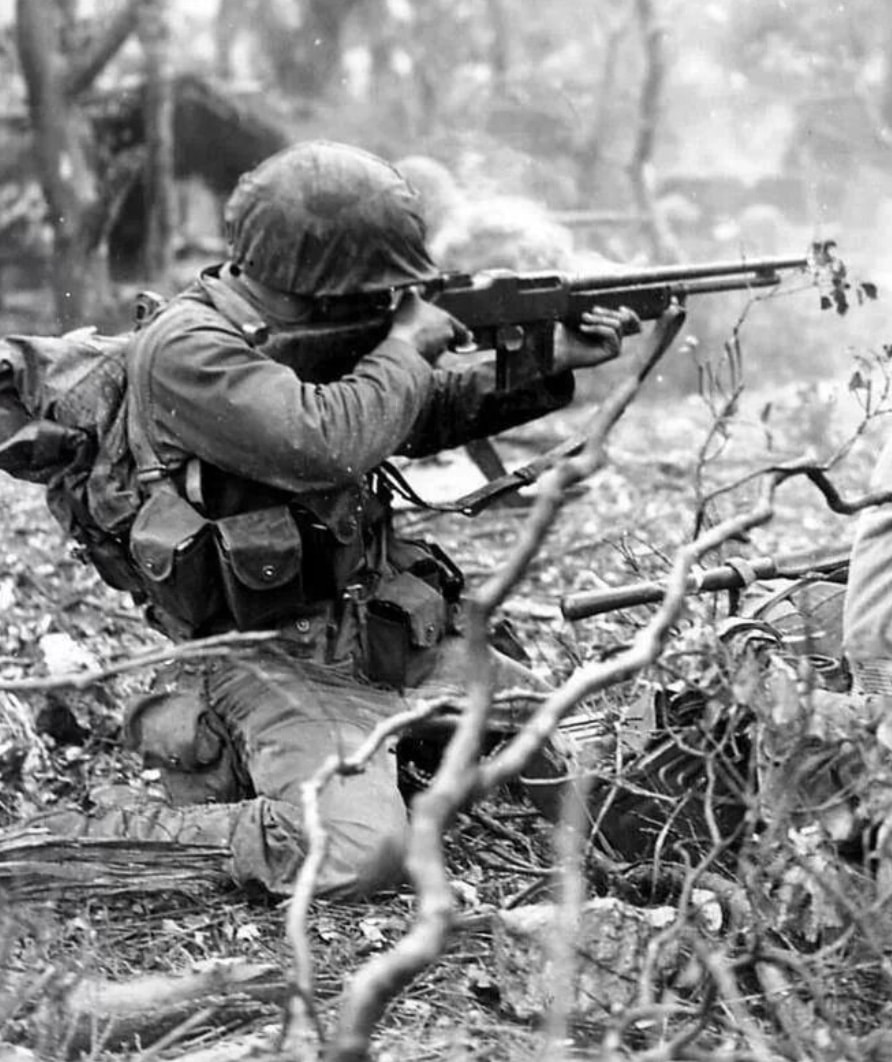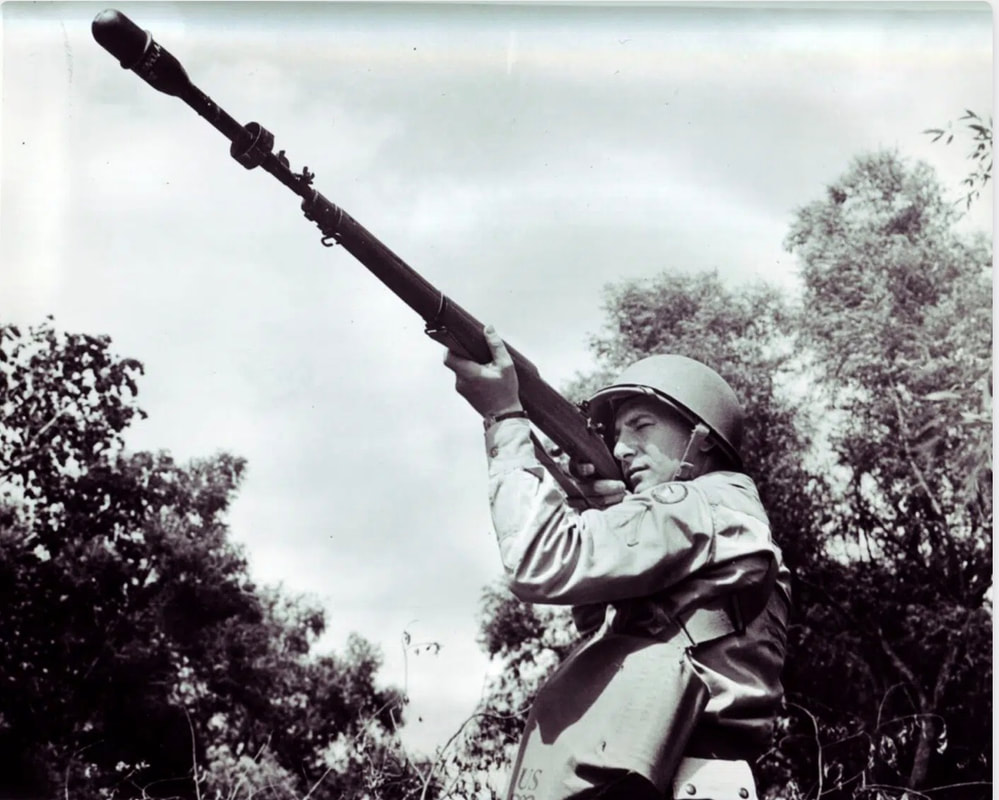bigpigeon.us webpage WWII US > Ground Forces > Infantry Organization, © 2023 by Robert A. Christiansen, updated by RAC 11 Jan 2023.
The organizational structure for WWII US Army infantry units, from largest to smallest, was
division > regiment > battalion > company > platoon > squad.
The organizational structure for WWII US Army infantry units, from largest to smallest, was
division > regiment > battalion > company > platoon > squad.
Links to Big Pigeon's Infantry Division Organization webpages:
- Infantry Division Equipment (incomplete)
➨➨ WWII US Army Infantry Division Organization
|
Along with an headquarters company and some components smaller than a company in size, each WWII Army infantry division contained the organic (i.e., permanent) units shown on the accompanying chart:
|
Note that a WWII US Army infantry division included units from the following US Army branches besides the Infantry:
- Field Artillery
- Corps of Engineers
- Cavalry Corps - abolished after WWII
- Signal Corps
- Ordnance Corps
- Quartermaster Corps
- Military Police Corps
- Medical Corps
➨ Within a WWII US Infantry Division, an Infantry Regiment
|
WWII Army and Marine Corps infantry regiments had a similar organization. Each regiment had three battalions, and each battalion had four companies:
Note how a company is identified by a letter. If you know the company letter you can identify the battalion. |
➨ Within a WWII US Army Infantry Division - the Divisional Artillery
|
In 20th century wars, artillery fire caused more casualties than small arms fire.
Supporting this fact, the US Army deployed massive amounts of artillery in WWII. Each infantry division contained four artillery battalions, with additional battalions held in corps and army reserve. Note from the accompanying graphic that WWII divisional artillery, known as divarty, was authorized to have 36 105mm howitzers and 12 155mm howitzers. During WWII most artillery, except in armored artillery battalions, was towed rather than self-propelled. |
US Army Infantry division artillery:
Army Light Armored division:
- Three battalions of 105-mm howitzers and one of 155-mm howitzers.
- In addition, each infantry regiment had a 105-mm howitzer cannon company and a 57-mm gun antitank company.
- Four or five artillery battalions, organized into a 4th regiment; e.g., the 22nd Marine Regiment (artillery) was the 4th regiment in the 1st Marine Division.
- Early in WWII, a marine division’s artillery regiment had three battalions of 75-mm pack howitzers and one of 105-mm howitzers.
- As the war progressed, more 105-mm howitzers were added and the number of pack howitzers was reduced.
Army Light Armored division:
- Three battalions of self-propelled 105-mm howitzers mounted on the M7 Priest motor carriage.
- Artillery battalions were generally equipped with 75-mm pack howitzers.
- In WWII airborne operations, heavier equipment landed in gliders. www.trailblazersww2.org/history_infantrystructure.htm
WWII US Infantry Division, Commentary:
An ETO focus group after WWII ended indicated strong support for augmenting an infantry division thusly:
An ETO focus group after WWII ended indicated strong support for augmenting an infantry division thusly:
- Increase the Engineer Corps battalion to a two-battalion regiment.
- The current Cavalry Reconnaissance Troop is inadequate; no consensus on changes.
- Add more trucks to the Quartermaster Corps component.
- Add organic armored units of a battalion or more. In the ETO, a tank or anti-tank battalion had almost always been attached to an infantry division.
- Add an organic anti-aircraft battalion. (RAC smaller anti-aircraft weapons could also be successfully used against ground target, as the Wehrmacht had demonstrated).
➨➨ WWII US Army Infantry Regiment Organization
|
In 1941, the US Army had converted infantry divisions from rectangular (four infantry regiments) to triangular (three infantry regiments).
As noted earlier, each WWII infantry regiment had three infantry battalions, and each infantry battalion had three rifle companies and a heavy weapons company, identified thusly:
The accompanying diagram depicts an infantry regiment late in WWII. Changes from early WWII include:
|
➨ Within a WWII US Army Infantry Regiment, an Infantry Battalion
➨ Within a WWII US Army Infantry Regiment - the Anti-Tank and Cannon Companies
|
During the latter years of WWII, each US infantry regiment included the following two companies:
|
|
➨➨ WWII US Army Infantry Battalion Organization
|
Aside from battalion headquarters components, a WWII infantry battalion consisted of three rifle companies and a heavy weapons company.
A rifle company had three rifle platoons. The infantry battalion's heavy weapons company included .30 caliber water-cooled machine guns and 81mm mortars. Early in 1943, an anti-tank rocket known as the 2.36 inch Bazooka, was introduced.
|
|
➨ Within a WWII US Army Infantry Battalion - a Rifle Company
|
About the accompanying visual:
|
➨ Within a WWII US Army Infantry Battalion - the Heavy Weapons Company
|
I have not found a suitable organizational chart for a WWII US Army infantry heavy weapons company to include here.
The accompanying textual description is courtesy of https://en.wikipedia.org/wiki/Weapons_company. |
In February 1944, a full-strength US Army infantry heavy weapons company had 160 men in total, organized into a company headquarters, two machine gun platoons and a mortar platoon.
|
➨➨ WWII US Army Infantry Regiment Rifle Company and Rifle Platoon Organization
|
Aside from company headquarters components, a WWII US rifle company consisted of three rifle platoons and one weapons platoon.
As for motorized equipment, each rifle company, of about 193 men at full strength, was authorized only two jeeps! |
➨➨ WWII US Army Rifle Squad Organization
|
The following weapons appear in the accompanying diagram, which depicts the complement of a full-strength 12-man army infantry squad early in WWII:
|
About WWII US Army rifles:
The lighter, shorter US carbines of WWII eventually came in two flavors:
- The M1 Garand, introduced beginning in late 1937, was the standard weapon carried by most WWII rifleman. It was a semiautomatic rifle with an eight-round clip. At 43.5 inches in length, it weighted 9.5 pounds.
- Infantry squads generally included a heavier M1918A2, the BAR, Browning Automatic Rifle. At 47 inches in weight, it weighted 19.4 pounds and held a 20-round magazine.
- A platoon sniper and squad rifle grenadiers generally carried a M1903 Springfield rifle.
The lighter, shorter US carbines of WWII eventually came in two flavors:
- M1, introduced 1942, semiautomatic, 35.6 inches in length and 5.2 pounds unloaded, generally used a 15-round magazine.
- M2, introduced October 1944, same specifications but with a fully-automatic mode, not widely used in WWII, generally used a 30-round banana magazine.
Sources for Big Pigeon's WWII US > Ground Forces > Infantry Division Organization webpage:
General Sources:
General Sources:
- The Infantry - Organization for Combat, WWII, https://www.trailblazersww2.org/history_infantrystructure.htm - by Hugh Foster, 2000 - a well-written description of WWII Army infantry division organization.
- The Infantry Regiment 1941-45, https://tmg110.tripod.com/usarmy_ir.htm, by Thomas M. Gregg.
- U.S. Army Rifle Company (1942-43), https://www.battleorder.org/usa-riflecoy-1942 - a detailed and well-organized explanation of the early WWII rifle company TO&E.
- US Army Rifle Company (1944-45), https://www.battleorder.org/post/usa-rifleco-1944- a detailed and well-organized explanation of the late WWII rifle company TO&E.
- https://www.trailblazersww2.org/pdf/eto-015.pdf
- Bazooka Team, France 1944, the webpage header photo, https://www.wearethemighty.com/articles/heres-how-the-bazooka-became-ikes-favorite-weapon-during-world-war-ii/.
- WWII US Army Infantry Division, Organizational Chart, https://upload.wikimedia.org/wikipedia/commons/e/e6/United_States_World_War_II_Infantry_Division_1942_Structure.png - taken from the out-of-print book US Army Infantry Divisions 1942-43 by John Sayen.
- WWII US Army Rifle Squad, https://www.battleorder.org/post/usa-rifleco-1944 - c/o https://www.battleorder.org. This graphic depicts a full-strength WWII Army infantry division rifle squad.
- TO&E Outline for a WWII Infantry Regiment - https://www.custermen.com/ItalyWW2/ArmyOrg/OrgChart/Charts.htm.
- TO&E Outline for WWII Infantry Divarty - https://www.custermen.com/ItalyWW2/ArmyOrg/OrgChart/Charts.htm.
- https://upload.wikimedia.org/wikipedia/commons/e/e6/United_States_World_War_II_Infantry_Division_1942_Structure.png
- https://tmg110.tripod.com/usarmy_ir.htm
- https://www.trailblazersww2.org/units_organization.htm
- https://www.trailblazersww2.org/orgcharts/battalion001.jpg
- WWII US Army Infantry Anti-tank Company, excerpted from https://tmg110.tripod.com/usarmy_ir.htm.
- WWII US Army Infantry Cannon Company, https://static.wixstatic.com/media/a137e0_47a773b5e822430bbee4577cd50824e4~mv2.png.
- https://www.trailblazersww2.org/giweapons.htm
